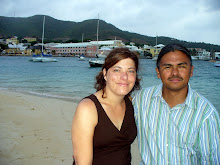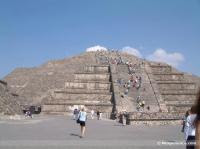 Before meeting up with Debbie and Alan, we visited the village of Tlacochahuaya to see their beautiful church, the Templo y Ex-Convento de San Jeromino. The 16th century church is being restored and there were many workers painting, sanding and cleaning while we were there. Nevertheless, it is beautiful, and I’m sure once the restoration is finished it will be stunning. The organ (above left), in particular, is gorgeous.
Before meeting up with Debbie and Alan, we visited the village of Tlacochahuaya to see their beautiful church, the Templo y Ex-Convento de San Jeromino. The 16th century church is being restored and there were many workers painting, sanding and cleaning while we were there. Nevertheless, it is beautiful, and I’m sure once the restoration is finished it will be stunning. The organ (above left), in particular, is gorgeous. We met up with Debbie and Alan at the small village of Santa Maria del Tule, home to a spectacular 2,000 year old tree. The tree, known as El Tule, really has to be seen to be appreciated. It’s simply massive.
We met up with Debbie and Alan at the small village of Santa Maria del Tule, home to a spectacular 2,000 year old tree. The tree, known as El Tule, really has to be seen to be appreciated. It’s simply massive. From here we followed our friends to the home of Felipe, a Zapotec man who learned the weaving tradition from his father and grandfather. Many of the families in the village of Teotitlan del Valle weave rugs, and as we drove through town, we could see looms through windows and doors. Felipe and his family showed us the process of carding and spinning wool. Felipe uses only natural dyes in his rugs, and we received a demonstration of how some of the colors are made. The brilliant red color comes from the cochineal, a small bug that lives and feeds on cacti. The yellows come from marigolds and blues comes from a plant source as well.
From here we followed our friends to the home of Felipe, a Zapotec man who learned the weaving tradition from his father and grandfather. Many of the families in the village of Teotitlan del Valle weave rugs, and as we drove through town, we could see looms through windows and doors. Felipe and his family showed us the process of carding and spinning wool. Felipe uses only natural dyes in his rugs, and we received a demonstration of how some of the colors are made. The brilliant red color comes from the cochineal, a small bug that lives and feeds on cacti. The yellows come from marigolds and blues comes from a plant source as well. Felipe explained and demonstrated the multi-step process to dye the wool and then we watched his son and daughter-in-law do some weaving. Felipe is the head of the family business, and has brothers and cousins who weave for him. Felipe does all the dying and designs the majority of the patterns for the rugs. Ninety percent of their rugs are exported to Arizona, were the large ones retail for as much as $6,000 (U.S., not pesos!). It was truly fascinating and we were so impressed by the artisanship of the family. Of course, we bought a couple of rugs!
Felipe explained and demonstrated the multi-step process to dye the wool and then we watched his son and daughter-in-law do some weaving. Felipe is the head of the family business, and has brothers and cousins who weave for him. Felipe does all the dying and designs the majority of the patterns for the rugs. Ninety percent of their rugs are exported to Arizona, were the large ones retail for as much as $6,000 (U.S., not pesos!). It was truly fascinating and we were so impressed by the artisanship of the family. Of course, we bought a couple of rugs! 
Next we went to lunch and had a wonderful conversation with our new friends as well as Felipe. It was wonderful to learn more about Felipe’s life and a little about Zapotec culture. With his family and among the workers at the restaurant, Felipe spoke Zapotec. What a window into another life.
 After lunch we checked out the village’s church, the Templo de la Preciosa Sangre de Cristo (the Temple of Christ’s Precious Blood). The church was built on the site of an earlier Zapotec temple, and some of the carved rocks from the temple were incorporated into the church (see pictures below). We ended our visit in Teotitlan with a stop at the community’s small museum. Included were pre-Hispanic Zapotec artifacts, information on the area’s history, and weaving displays. Among the interesting things I learned was that the Zapotec paid tribute to the Aztecs with woven rugs. Clearly there is a long tradition of weaving in this community. Signs at the museum were in three languages: Spanish, English and Zapotec. I enjoyed seeing how well preserved the culture of the Zapotec is.
After lunch we checked out the village’s church, the Templo de la Preciosa Sangre de Cristo (the Temple of Christ’s Precious Blood). The church was built on the site of an earlier Zapotec temple, and some of the carved rocks from the temple were incorporated into the church (see pictures below). We ended our visit in Teotitlan with a stop at the community’s small museum. Included were pre-Hispanic Zapotec artifacts, information on the area’s history, and weaving displays. Among the interesting things I learned was that the Zapotec paid tribute to the Aztecs with woven rugs. Clearly there is a long tradition of weaving in this community. Signs at the museum were in three languages: Spanish, English and Zapotec. I enjoyed seeing how well preserved the culture of the Zapotec is.





How interesting to see the rugmaking process firsthand. The finished product is absolutely gorgeous!
ReplyDelete